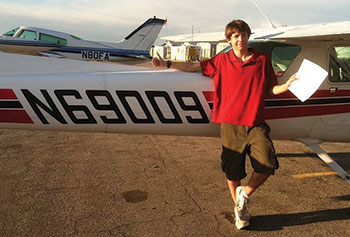Pilot Briefing
News from the world of general aviation
HondaJet delayed by engine icing test
 HondaJet first deliveries could be delayed to 2013, following the discovery of a problem with the HF120 engine during an icing test by GE Honda Aero Engines. The problem appears to be fixed, but engine certification will be delayed until the second half of 2012.
HondaJet first deliveries could be delayed to 2013, following the discovery of a problem with the HF120 engine during an icing test by GE Honda Aero Engines. The problem appears to be fixed, but engine certification will be delayed until the second half of 2012.
The HF120 engine failed to pass an on-ground ice ingestion test, leading to a redesign. The test involved slab ingestion such as might occur if the engine's anti-icing system were to fail, said William Dwyer, president of GE Honda Aero Engines. The engine is required to show it can ingest a sizeable chunk, defined by FAA standards, and have "negligible" loss of power. Instead, it kept safely running but had a "perceptible" loss of power, Dwyer said. That led to the design of thicker fan blades and retesting.
More will be known about the exact schedule by May or June 2012. "We will check at the end of the year for a better update," said HondaJet spokesman Mark Lee.
HondaJet officials also announced that a $20 million maintenance repair and overhaul facility would be located in Greensboro, North Carolina. The center will provide services that complement those offered to owners at smaller service centers across the HondaJet dealer network.
Former AOPA Pilot editor publishes book 
Julie Boatman Filucci, a former technical editor for AOPA Pilot, has published Together We Fly: Voices From the DC-3 through Aviation Supplies & Academics Inc. Filucci recounts fascinating stories of the 75-year-old iconic aircraft in her 192-page flight through time. Available in hard and soft cover from ASA.
Execs out, jet program suspended at Piper
Piper Aircraft changed its leadership in mid-October and said it is suspending its PiperJet Altaire program.
Simon Caldecott, a 37-year veteran of the aviation industry and Piper's vice president of operations since 2009, has replaced Geoff Berger as chief executive officer. Caldecott has been responsible for manufacturing operations and engineering, quality, and the supply chain at Vero Beach, Florida-based Piper. Prior to becoming the Piper CEO, Berger was a managing director at Imprimis, a Singapore-based investment firm that invested in Piper on behalf of the government of Brunei. The firm opened an office in Brunei. A Piper official said Berger left Imprimis when he became a Piper employee.
Caldecott said that Executive Vice President Randy Groom was also leaving Piper.
Caldecott assured employees and the industry that the company would promptly address questions related to the PiperJet Altaire single-engine jet program, in consideration of jet market forecasts and the company's overall financial strategy. A company official said forecasts show the future jet market "will not be strong." Most forecasts show the aerospace market recovering by 2013, with different conclusions about whether 2012 is flat or shows improvement. Morgan Stanley aerospace stock analyst Heidi Wood told AOPA Live that corporations have the cash now to buy business jets, if not the confidence in the economy, and she is optimistic that willingness to spend some of that cash will emerge in 2012 and 2013.
Piper displayed a mockup of the aircraft at EAA AirVenture in Oshkosh, Wisconsin, this summer during a 16-state tour. The company had assigned nearly 200 engineers and production staff to the project, and is working to complete $5.6 million in building renovations for production in Vero Beach.
It is likely the building renovations will continue. A company official said the building, and most of the sophisticated new manufacturing machines purchased for the jet, can be used for existing aircraft.
The company "continues to achieve internal financial and delivery targets for the existing turboprop and piston product lines," Caldecott said. Those deliveries have increased as "business and training aircraft continue to outperform the marketplace in their aircraft categories."
Caldecott credited Berger for seeing the company through "many important changes." He praised Groom for contributions to Piper's globalization efforts, and for leadership.
Before coming to Piper, Caldecott was a vice president at Raytheon Aircraft, and more recently, vice president of assembly operations with successor firm Hawker Beechcraft. He worked as a design engineer for British Aerospace on development of the Hawker mid-size business jet, eventually assuming responsibility for manufacturing, assembly, flight testing, and completion of Hawkers, said the Piper announcement.
—Dan Namowitz, AKM
Test Pilot
By Barry Schiff
1. From reader Kim Schroer: Two airplanes are flying in a circular formation. Which of the two airplanes, the one on the inside or the one on the outside, experiences the slightly greater G load?
 2. A pilot about to land notices solid-yellow circles that are 10 feet in diameter painted across a runway. What do these circles indicate?
2. A pilot about to land notices solid-yellow circles that are 10 feet in diameter painted across a runway. What do these circles indicate?
3. From reader John Schmidt: True or False? The Ryan model NYP—the letters stood for "New York to Paris"—was the airplane specifically built for Charles Lindbergh's trans-Atlantic flight. Ryan built only one of these aircraft.
4. At any time when Air Force One is not airborne, it is factually true that it has made one more takeoff than it has made landings but has never crashed. How is this explained?
5. How many U.S. aircraft carriers (CVs) were commissioned and/or served during World War II?
a. 14
b. 24
c. 34
d. 44
6. The dizzying effects of an inverted spin make it difficult to quickly determine which rudder to apply when attempting recovery. Therefore, the pilot should apply rudder
a. opposite to the turn needle.
b. opposite to the turn coordinator.
c. opposite to the slip/skid ball.
d. None of the above.
7. From reader Dorie Schiff: On February 3, 1959, a Beechcraft Model 35 Bonanza crashed near Clear Lake, Iowa. Why did Don McLean refer to this event as "the day the music died" in his 1971 hit song, American Pie?
8. St. Elmo's fire is a luminous discharge of static electricity that appears on (and sometimes in) an aircraft during flight in strong electrical fields, especially when in clouds near thunderstorm activity. Who is St. Elmo?
News from NBAA
Cessna offers two new jets
Cessna Aircraft had two new offerings at the National Business Aircraft Association convention in Las Vegas this year, an M2 step-up airplane for Mustang owners and Latitude for XLS owners reaching for an aircraft with a six-foot cabin.
The M2 is based on the CJ1+. The $4.195 million aircraft fills the gap between the Mustang entry-level jet and the Citation CJ family. It can carry two crew and up to six passengers at a maximum cruise speed of 400 knots true airspeed. It has a Garmin G3000 glass cockpit and is aimed at the Embraer Phenom 100, a close competitor.
The Latitude, meant to evoke mental images of navigation, has an initial offering price of $13.9 million and a base price of $14.9 million, placing it between the $12.2 million Citation XLS+ and the $16.99 million Citation Sovereign models. The Latitude project got its start just three months prior to the 2011 NBAA convention.
The wing, engine nacelles, tail, and mechanical flight controls are like those on the Sovereign, although winglets that one Cessna marketing executive likes to call Eco-tips will be added. The most important feature of the all-new aluminum fuselage is the flat-floor, six-foot cabin height. It maintains a 6,000-foot cabin pressure at 45,000 feet. The fuselage includes bigger windows and an electrically actuated larger airstair door. It uses trailing-link landing gear and will have a takeoff weight slightly more than 28,000 pounds.
The model is aimed at the Embraer Legacy 450 that will fly in 2012, two years before the Latitude. The 450 has a launch price in excess of $1 million more than the Latitude launch price. It will enter service in 2013, two years before the Latitude. It also has a flat-floor cabin but has a cabin height that is one-half-inch less than the Latitude.
Anger at Obama administration a theme
Remarks by President Barack Obama comparing private jets to unwarranted luxury became a lightning rod for anger by speakers at the NBAA convention. The strongest came from Hawker Beechcraft Chairman and CEO Bill Boisture.
Boisture said targeting of the private aircraft industry in terms of both user fees and fiscal proposals appears to be intentional, and called fiscal policies such as the fees and unfavorable aircraft depreciation schedules "irresponsible."
The perceived attacks have damaged customer confidence and contributed to some, perhaps "the most recent 25 percent," of all employee layoffs and workforce reductions, Boisture said. "To have singled out our industry is irresponsible," he said.
Boisture said his staff decided long ago to treat the current recession as "the new normal," and added that unfortunately that has proven true. "The only consistent thing we see is inconsistency," he said. He added that, "…2012 looks like 2011, which looks like 2010." What remains is a smaller, agile, efficient, and flexible company, he said. Nearly 1 million square feet of factory space has been closed, and 20,000 parts have been transferred to third-party manufacturers or to facilities in Mexico.
He said the new strategy to improve and retrofit existing products is seen in the Hawker 400XPR upgrades. The upgrades apply as well to the piston-engine models, the twin-engine Baron, and the Bonanza, which received newly designed interiors and cabin-temperature control systems.
Eclipse 550 deliveries to start in 2013
Eclipse Aerospace announced that it is taking orders for the Eclipse 550 twin-jet with first deliveries scheduled to begin in 2013.
The 550 is a derivative of the Eclipse 500, which was certified in 2006. However, only about 260 of the aircraft were delivered before the manufacturer, Eclipse Aviation, filed for bankruptcy protection in November 2008. Eventually liquidated, the assets were purchased in August 2009 by a group of owners headed by entrepreneur Mason Holland, who serves as the CEO and chairman of the new company, Eclipse Aerospace.
Eclipse Aerospace has been refurbishing and upgrading the existing fleet since its inception. Last year, the company announced that Sikorsky Aircraft had bought a minority share of the company and planned to provide its expertise in supply chain management and disciplined processes to improve productivity.
The latest announcement leverages Sikorsky's expertise and assets further through a memorandum of understanding (MOU) that will have the major subassemblies of the 550 built in a Sikorsky-owned plant in Mielec, Poland. There, PZL Mielec, a Sikorsky company, builds Blackhawk helicopters and various aircraft of Polish design.
Under the MOU, Sikorsky will build the wings, empennage, and fuselage in Mielec. Those components will be shipped to the Eclipse plant in Albuquerque, New Mexico, for final assembly. Under the original company, the wings were built in Japan, the empennage in Dallas, and the fuselage in Albuquerque.
Eclipse Aerospace co-founder Mike Press expects about the first 30 aircraft to be built in Albuquerque while Polish workers learn the processes. At that point, the innovative friction-stir-welding equipment and other production gear will be shipped to Mielec for continued manufacturing.
Holland reported that about 85 percent of the suppliers for the new airplane are under contract; all of them were suppliers to the original company.
The 550 differs from the original 500 through upgraded systems, including autothrottles, which were originally envisioned for the 500 but never implemented. Other enhancements include upgrades to the Innovative Solutions & Support cockpit system, including synthetic and enhanced vision.
Holland said the company expects to produce between 50 and 100 airplanes annually once production stabilizes. Base price for the new airplanes is set at $2.7 million. A limited number of introductory position holders will receive a contract without CPI escalation clauses and will be eligible for some $120,000 in optional equipment for no extra cost.
—Thomas B. Haines
High school senior can fly, not drive
High school senior Joe Lempa, 17, can fly an airplane above the Chicago area as a private pilot, but he hasn't had time to get that driver's license yet. "I'm going to have to take a weekend and get that done," he said.
 Lempa was chosen by A and M Aviation at Clow International Airport in Bolinbrook, Illinois, to receive an all-expense-paid private pilot course. Since his dad is an airline pilot and his mother works, it fell to his grandfather to drive him to the lessons, wait, and drive him home. In eight to 10 weeks last summer he was a private pilot.
Lempa was chosen by A and M Aviation at Clow International Airport in Bolinbrook, Illinois, to receive an all-expense-paid private pilot course. Since his dad is an airline pilot and his mother works, it fell to his grandfather to drive him to the lessons, wait, and drive him home. In eight to 10 weeks last summer he was a private pilot.
He wrote the winning essay in the contest and had the grades to prove he could quickly complete the course. A and M co-owner Jolan Harvilchuck said she and her husband wanted to give something back to aviation. "It was a way for us to promote general aviation and our airport," said Harvilchuck. "He was on the schedule five or six days a week—we spent time on the ground grooming him using the Cessna kit."
Was it a grind? "It was like a very, very cool school class," Lempa said. "Every 17-year-old should have the chance for this experience." He and instructor Ross Healey flew five days a week and sometimes more. "My father is very proud of me," Lempa said. "I got it faster than he did, and got a higher score on my written than he did. My dad can't wait to fly with me. Some of my friends are saying 'Take us up!' I am going to wait on that." He said his friends are surprised and impressed.
A and M owners are so pleased with the result they are considering offering a similar contest every year.
Now that he is a pilot, Lempa may consider aviation as a career. He is interested in aeronautical engineering at present, but might also explore a career as a pilot for the National Oceanic and Atmospheric Administration. NOAA has approximately 50 pilots, all of whom are officers with the NOAA Corps—one of the seven uniformed services of the United States. NOAA aviators fly the agency's specialized aircraft, including the WP-3D Orion and Gulfstream IV hurricane hunters and a variety of twin-engine aircraft used for gathering environmental and geographic data. Missions include aiding in winter storm forecasts, assessing post-storm damage, studying marine mammal populations, and investigating oil spills.
TEST PILOT ANSWERS
1. Both airplanes must have the same turn rate, and the one on the outside must have a greater airspeed (to fly the larger circle). The outside airplane, therefore, requires a greater bank angle and must be experiencing the greater G load.
2. They indicate the presence of arresting gear. This might prevent an overrun but would be hard on the propeller.
3. False. Ryan built a second NYP that was sold to Japan and flown on a number of publicity tours. No one knows what eventually happened to the airplane.
4. When Richard M. Nixon left office in 1974, his resignation became effective after departing Andrews Air Force Base on Air Force One. Gerald Ford was sworn into office while the aircraft was en route to California. At this moment, Nixon's flight lost its presidential designation and assumed a military flight number.
5. c. The oldest carrier to serve in the war was the USS Langley (CV 1), which was commissioned in 1922. The last carrier to serve in the war, the USS Lake Champlain (CV 39), was commissioned on June 3, 1945.
6. a. The turn coordinator and the slip/skid ball do not provide reliable recovery guidance during an inverted spin.
7. The accident claimed the lives of legendary rock-and-roll pioneers Buddy Holly, Ritchie Valens, and J.P. "the Big Bopper" Richardson (as well as the 21-year-old pilot, Roger Peterson).
8. St. Elmo is the patron saint of sailors, who observed this phenomenon as static electricity dancing on the masts of ancient sailing vessels. Reducing airspeed usually reduces the intensity of St. Elmo's fire.


